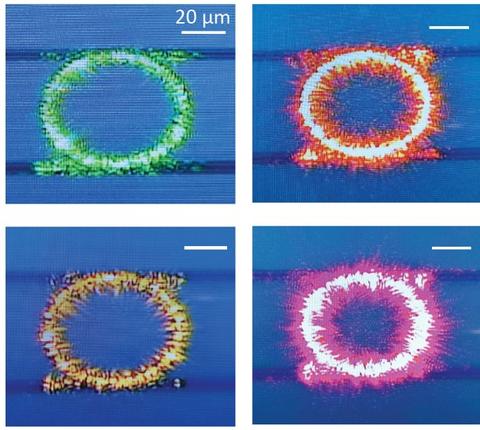Improved Chip-Scale Color Conversion Lasers Could Enable Many Next-generation Quantum Devices

In two new studies, researchers at the National Institute of Standards and Technology (NIST) have greatly improved the efficiency and power output of a series of chip-scale devices that generate laser light at different colors while all using the same input laser source.
Many quantum technologies, including miniature optical atomic clocks and future quantum computers, will require simultaneous access to multiple, widely varying laser colors within a small region of space. For instance, up to six different laser colors are needed for all the steps required for a leading atom-based design for quantum computation, including preparing the atoms, cooling them, reading out their energy states, and performing quantum logic operations.
To create multiple laser colors on one chip, NIST researcher Kartik Srinivasan and his colleagues have spent the last few years studying nonlinear optical devices, such as those made of silicon nitride, which have a special property: The color of laser light entering the device can differ from the color that exits. In their experiment, incoming light is converted into two different colors—which correspond to two different frequencies. For instance, near-infrared laser light incident on the material is converted into shorter-wavelength visible laser light (at higher frequency than the source) and longer-wavelength infrared laser light (at lower frequency).
In previous work, the team demonstrated that this conversion process, known as optical parametric oscillation, can occur within a silicon nitride microresonator, a ring-shaped device small enough to be fabricated on a chip. The light races around the ring some 5,000 times, building a high enough intensity for the silicon nitride to convert it into the two different frequencies. The two colors are then coupled into a straight rectangular channel, also made of silicon nitride, that lies adjacent to the ring and acts as a transmission line, or waveguide, transporting the light where it is needed.
The specific colors generated are determined by the dimensions of the microresonator as well as the color of the input laser light. Because many different microresonators with slightly different dimensions are created during the fabrication process, the technique provides access to a wide range of output colors on a single chip, all using the same input laser.
However, Srinivasan and his colleagues, which include researchers from the Joint Quantum Institute (JQI), a collaboration between NIST and the University of Maryland, found that the process was highly inefficient. Much less than 0.1 percent of the input laser light was converted into either of the two output colors traveling in the waveguide. The team traced most of the inefficiency to poor coupling between the ring and the waveguide.
In the first study, Srinivasan and his NIST/JQI collaborators, led by Jordan Stone, redesigned the straight waveguide so that it was U-shaped and wrapped around a portion of the ring. With this modification, the researchers were able to convert about 15 percent of the incoming light to the desired output colors, more than 150 times the amount in their earlier experiment. In addition, the converted light possessed more than one milliwatt of power over a wide range of wavelengths, from the visible to the near-infrared.
Generating a milliwatt of power is a milestone, said Srinivasan, because that amount is usually enough for several applications. For example, it can enable a tiny laser to excite electrons to jump, or transition, from one specific energy level to another inside an atom. Exciting these transitions is part of common protocols for generating quantum states of light, such as single-photon states, from single atoms or atom-like systems such as quantum dots.
In addition, milliwatt power levels can be sufficient for laser stabilization. Some atoms have transition energies that are very stable and insensitive to environmental effects, and as a result, provide a good reference by which a laser frequency can be compared and corrected, ultimately improving its noise properties.
The researchers reported their results in the December 2, 2022 issue of APL Photonics.
In the second study, Srinivasan and his colleagues, led by Edgar Perez, improved the power output and efficiency of the technique even further. By increasing the coupling between the ring and the waveguide and suppressing effects that may interfere with the color conversion, the team increased the output laser power to as high as 20 milliwatts and converted as much as 29 percent of the incident laser light to the output color. Although the colors in this study were limited to the near-infrared, the team plans to extend their work to visible wavelengths.
The researchers reported their findings in the Jan. 16, 2023 issue of Nature Communications.
Papers:
Perez EF, Moille G, Lu X, Stone J, Zhou F, Srinivasan K. High-performance Kerr microresonator optical parametric oscillator on a silicon chip. Nature Communications. 14: 242. Published online Jan. 16,2023. PMID 36646688 DOI: 10.1038/s41467-022-35746-9.
Stone JR, Lu Xiyuan, Moille G, Srinivasan K. Efficient chip-based optical parametric oscillators from 590 to 1150 nm. APL Photonics 7, 121301 (2022), https://doi.org/10.1063/5.0117691. Published online Dec. 2, 2022.

